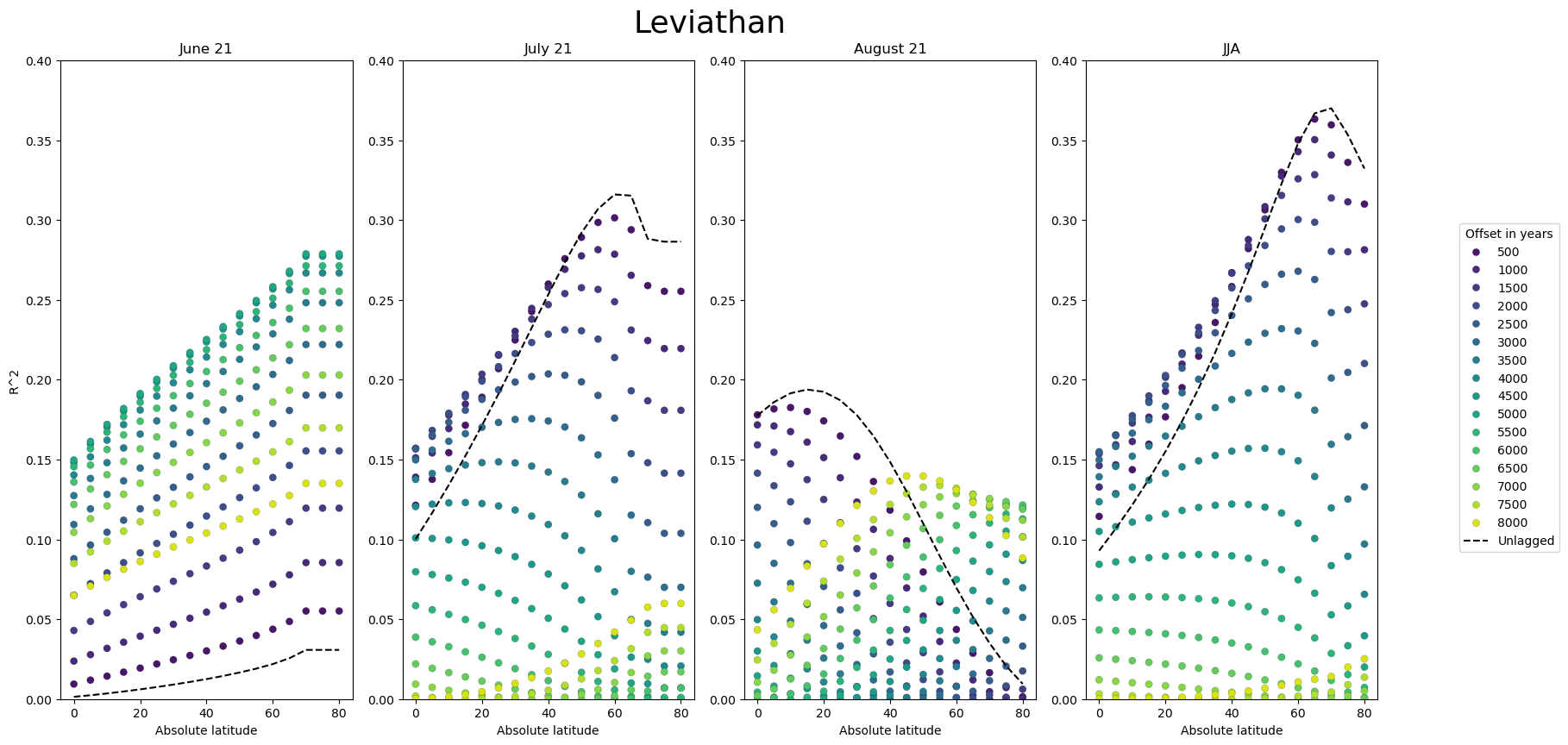Calculating shifted correlations#
This notebook lays out the details of how we use Pyleoclim to calculate the correlation between a record of oxygen isotope data from Leviathan cave and insolation and various latitudes and seasons. It shows how the strength and timing of the relationship changes depending on which month we choose for our insolation curve.
The notebook is structured as follows:
Define a function that will be used to calculate correlations between records that contain large hiatuses
Define insolation curves using climlab
Calculate correlation between shifted insolation and oxygen isotope data from Leviathan cave
Plot results
# Importing relevant packages
import math
import pickle
import pyleoclim as pyleo
import numpy as np
import seaborn as sns
import matplotlib.pyplot as plt
import pandas as pd
from climlab.solar.orbital import OrbitalTable
from climlab.solar.insolation import daily_insolation
# Importing the data
with open("../../data/geo_ms_composite_dict.pkl", "rb") as handle:
geo_ms = pickle.load(handle)
# Extracting the data
leviathan = geo_ms["Leviathan.Nevada.2017"]
This is the same correlation function from the Toy Data Heuristic notebook. See that notebook for more details.
# Correlation function for series with gaps
def correlate_hiatus_series(series1, series2, cutoff_scale1=None):
"""Function to correlate series with large gaps. This is done by segmenting the time series, smoothing (if this is desired),
and then reconnecting the time series with a dummy time axis so as not to re-introduce the hiatuses.
series1 : pyleoclim.Series
One series to correlate, presumed to have hiatuses
series2 : pyleoclim.Series
Other series to correlate, presumed to not have hiatuses
cutoff_scale : int
Cutoff scale for smoothing for series 1
"""
if cutoff_scale1:
segments = series1.segment()
if isinstance(segments, pyleo.core.multiplegeoseries.MultipleGeoSeries):
smoothed_series_value = []
smoothed_series_time = []
for segment in segments.series_list:
if max(segment.time) - min(segment.time) > 6:
segment_smooth = segment.interp().filter(cutoff_scale=cutoff_scale1)
smoothed_series_value.extend(segment_smooth.value)
smoothed_series_time.extend(segment_smooth.time)
smoothed_series = series1.copy()
smoothed_series.value = smoothed_series_value
smoothed_series.time = smoothed_series_time
else:
smoothed_series = series1.interp().filter(cutoff_scale=cutoff_scale1)
series1 = smoothed_series
smoothed_segments = series1.segment()
series1_values = []
series2_values = []
if isinstance(smoothed_segments, pyleo.core.multiplegeoseries.MultipleGeoSeries):
for segment in smoothed_segments.series_list:
ms = pyleo.MultipleSeries([segment, series2]).common_time()
s1, s2 = ms.series_list
series1_values.extend(s1.value)
series2_values.extend(s2.value)
assert len(series1_values) == len(series2_values)
time = np.arange(len(series1_values))
s1_corr = pyleo.Series(time=time, value=series1_values, verbose=False)
s2_corr = pyleo.Series(time=time, value=series2_values, verbose=False)
else:
s1_corr = series1
s2_corr = series2
corr = s1_corr.correlation(s2_corr, number=1, mute_pbar=True)
return corr
Creating insolation curves using climlab.
# Creating insolation objects
lat_list = np.arange(0, 81, 5)
inso_dict = {}
# array with specified kyears (can be plain numpy or xarray.DataArray)
years = np.arange(-1000, 1)
# subset of orbital parameters for specified time
orb = OrbitalTable.interp(kyear=years)
day_dict = {
"June 21": [152],
"July 21": [202],
"August 21": [233],
"JJA": np.arange(152, 243),
}
for day, num in day_dict.items():
inso_dict[day] = {}
for lat in lat_list:
if len(num) > 1:
inso = inso = daily_insolation(lat=lat, day=num, orb=orb).mean(dim="day")
else:
inso = daily_insolation(lat=lat, day=num[0], orb=orb)
inso_series = pyleo.Series(
time=0 - years[::-1],
value=inso[::-1],
time_name="Age",
time_unit="Kyr BP",
value_name=f"{day} : {np.abs(lat)} S",
value_unit="W/m^2",
verbose=False,
)
inso_dict[day][lat] = inso_series
Calculating correlation between insolation and shifted versions of the Leviathan record:
# Calculating correlations between insolation and Leviathan
shift_array = np.arange(0, 8.1, 0.5)
# shift_array = np.arange(-8,8.1,2)
series_shift_dict = {shift: {} for shift in shift_array}
orig_series = leviathan.convert_time_unit("kyr BP").flip()
lat = leviathan.lat
for day in day_dict.keys():
inso_lat_dict = inso_dict[day]
for shift in shift_array:
series = orig_series.copy()
series.time += shift
corr_res = {}
for corr_lat, corr_series in inso_lat_dict.items():
corr = correlate_hiatus_series(
series1=series, series2=corr_series, cutoff_scale1=5
)
corr_res[corr_lat] = [corr.p, corr.r]
correlated_inso = []
for corr_lat, res in corr_res.items():
corr_p, corr_r = res
correlated_inso.append([corr_lat, corr_p, corr_r])
series_shift_dict[shift][day] = correlated_inso
Loading data into a pandas DataFrame for plotting:
# Putting data into a DataFrame
series_df_dict = {}
for day in day_dict.keys():
columns = [math.ceil(a) for a in shift_array * 1000]
df = pd.DataFrame(index=np.arange(5, 81, 5), columns=columns)
for shift in shift_array:
corr_list = series_shift_dict[shift][day]
for corr in corr_list:
lat = np.abs(corr[0])
r = corr[2]
df.loc[lat, math.ceil(shift * 1000)] = r**2
series_df_dict[day] = df
Plotting results:
# Plotting the data
fig, ax = plt.subplots(nrows=1, ncols=4, figsize=(16, 8))
# fig.subplots_adjust(wspace=0.6, hspace=0.4)
fig.tight_layout()
axes = ax.ravel()
colors = sns.color_palette("colorblind")
for idx, pair in enumerate(series_df_dict.items()):
label, df = pair
scatter_df = df.drop(labels=0, axis=1)
sns.scatterplot(
scatter_df,
ax=axes[idx],
legend=True,
palette="viridis",
markers=["o" for _ in scatter_df.columns],
edgecolor="black",
linewidth=0.1,
)
sns.lineplot(
x=df[0].index.to_numpy(),
y=df[0].to_numpy(),
ax=axes[idx],
linestyle="--",
color="black",
label="Unlagged",
)
if idx == len(series_df_dict.keys()) - 1:
handles, labels = axes[idx].get_legend_handles_labels()
fig.legend(
handles,
labels,
loc="center right",
bbox_to_anchor=[1.12, 0.5],
title="Offset in years",
)
if idx in [0]:
axes[idx].set_ylabel("R^2")
axes[idx].set_xlabel("Absolute latitude")
axes[idx].get_legend().remove()
axes[idx].set_title(f"{label.split('.')[0]}")
axes[idx].set_ylim(0, 0.4)
plt.suptitle("Leviathan", y=1.05, fontsize=26)
Text(0.5, 1.05, 'Leviathan')

